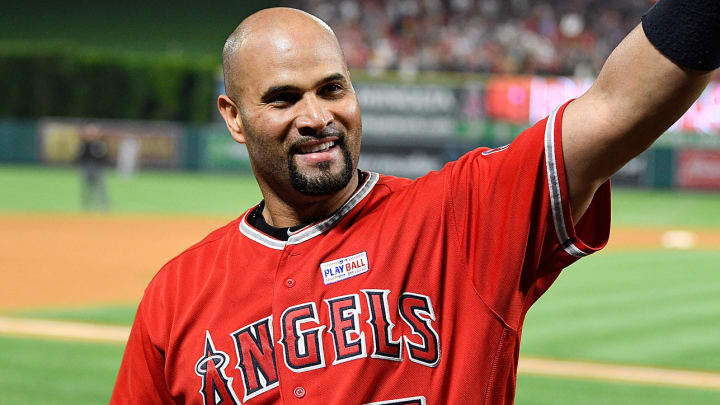Even with vintage home run to join 600 Club, Albert Pujols' milestone is bittersweet

To have Albert Pujols on your favorite baseball team in the early 2000s bred the most irrational of fans. I was one of them, and man, was it fun.
To have Albert Pujols on your favorite baseball team meant you didn’t leave games during rain delays, even when your team was behind and you didn't have an umbrella and those nasty Saran-wrap ponchos cost upwards of $10. You bought the poncho, and in the case of July 13, 2006, you waited in the upper deck, and you moved down behind the dugout when some friends spotted open seats next to theirs. You sat on the dripping red metal, and you watched your team tie the game. You waited through extra innings, until it was pushing midnight, until the bottom of the 14th inning, until Pujols. You watched him hit it out of the park on a 3-1 count, because of course he did.
That’s my Pujols story. The next day my photo was onto the cover of the St. Louis Post-Dispatch's sports section. There I am, beaming in the background as the slugger runs to first on the walkoff blast that gave the Cardinals a 3-2 win over the Dodgers. It’s my proudest moment in print journalism, I tell people, and they think I’m kidding.
It was the 231st home run of Pujols' career, and that night there was no question that he would one day get to 600. And it seemed like there was no question he’d do it for the Cardinals. I was 18 and naïve. I loved my baseball team more than I’d ever loved a boy. I was about to leave for college, and part of me expected the St. Louis I left that summer to stay there, frozen in time, forever. I’d never heard of plantar fasciitis or Jerry Dipoto and Arte Moreno. I didn’t know what $240 million could mean to a man.
Projecting career home run totals for 17 active sluggers, and why the 600 Club still matters
When Pujols hit No. 600 on Saturday night in a 7-2 win, it was the 14th grand slam of his career, his 2,876th hit. The four runs he drove in left him with 1,859 for his career; only 12 players have logged more. According to Statcast, the pitch, a hanging slider from the Twins' Ervin Santana, had just a 12% hit probability—which is much, much higher than the odds anyone would have assigned to a 13th-round draft pick from Maple Woods Community College in Kansas City, Mo., becoming at his peak the best player in the game.
Pujols’s debut in 2001 came about, according to Cardinals lore, because Mark McGwire told manager Tony La Russa he’d be crazy to send the kid back to the minors. La Russa’s team that spring was coming off its best season in 15 years, a 95-67 campaign that ended with an NLCS loss to the Mets. After a mediocre decade, this was a team that needed a homegrown star. Pujols would become that and more.
SI VAULT: Albert Pujols made a smashing MLB debut (04.16.2001), by Tom Verducci
In 11 years in St. Louis Pujols redefined the franchise, leading the Cardinals to just seven postseason appearances and two World Series titles. He won three NL MVP awards and finished in the top five seven other times. He spurned the nickname “El Hombre” because he thought it did a disservice to Stan (the Man) Musial. He was one of us. And then he left, for the Angels, for California, for money, for a change.
And change coincided with mortality. The Pujols who plays in Anaheim is a shadow of the player he was in St. Louis, which is why it’s possible to view his career in these two disparate chunks. He went from Superman to rarely super, from an October regular to an October rarity. Maybe that’s why 600 felt so bittersweet, why it seemed like baseball wasn't quite as excited as it should have been.
Heralded Angel Swings: Albert Pujols on his contract, his future and 600 home runs
I like to tell myself that had he done this as a Cardinal, I’d have seen the fireworks in St. Louis from my patio in Chicago, that Saturday would be a holiday in the state of Missouri. And I could be wrong. There are plenty other reasons this seemed subdued. There's the Steroid Era and the way it inoculated baseball to the awe of the home run, and by extension these events. There’s the plantar fasciitis in Pujols's right foot that caused him to miss 63 games in 2013 and has hobbled him since. There’s his age—he turned 37 in January—and the miles he put on his body in 74 postseason games as a Cardinal. (He’s played in just three since, all losses, as the Angels were swept by the Royals in the 2014 ALDS.) His production has fallen off steadily since 2012, and the player who had a career .328 batting average going into that season has batted just .265 since. But even if he limped to 600, even if the wait wasn’t a weeks-long buildup of anticipation, Pujols still did it with flair, becoming the first person ever to reach the milestone with a grand slam.
The nature of 600 is that it’s a milestone of longevity as much as it is of clout. Only eight other men are in the 600 Club, and half of them got there as their careers wound down. In fact, the next three players for Pujols to chase down—Ken Griffey Jr. (630), Sammy Sosa (609) and Jim Thome (612)—would all retire within two years of getting to that mark.
When Pujols hit No. 600 he looked like his vintage self: that narrow-eyed sneer at the plate, so calm it's terrifying. You feel bad for the ball. You're surprised, and then you're not, because he's still Albert Pujols.
